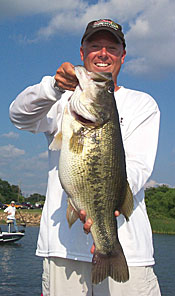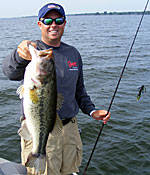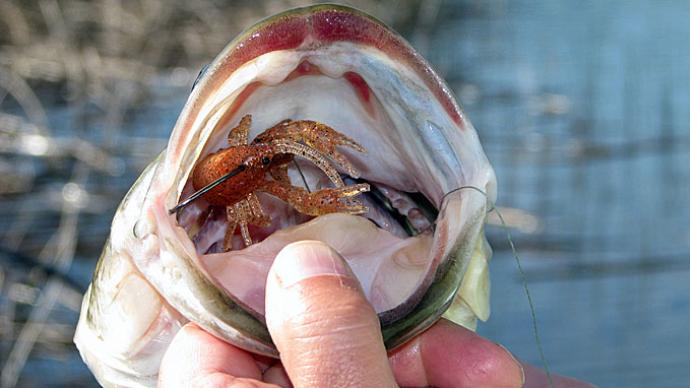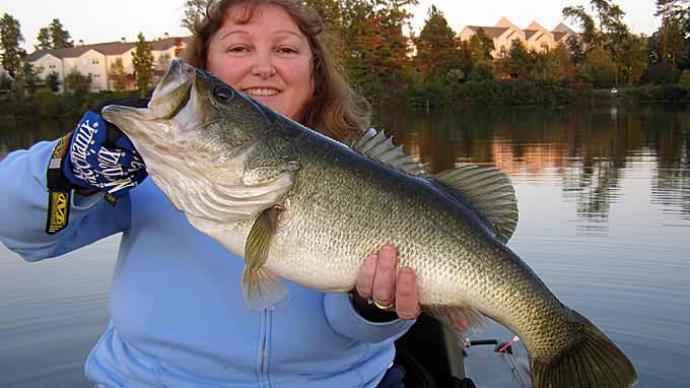
In late summer, hot temperatures and little rain typically drop water levels in many lakes. Meanwhile, abundant sunshine and clearer water simultaneously produce the most prolific weeds in our lakes. The combination of lowered water levels and exploding weed growth results in vast fields of matted grass beds.
This peaceful-looking flotilla of hydrilla, milfoil, and other submerged vegetation belie the labyrinth of tunnels beneath the surface where bass are actively feeding on bluegill and shad. From late summer through fall, flipping matted grass can make for outstanding shallow water fishing for big bass, even on the hottest and sunniest days of the year.
Based on the density of the cover, this is one technique where loading for bear is usually more productive than finesse tackle. Start with a7- to 8-foot heavy-power rod with a fast action tip and team it with a reel with 50- to 80lb braided line. The braided line cuts through dense weeds much better than other types of lines and affords you the power to handle big fish in the slop.
I'll use either a heavy Texas rig or an outsized jig on the business end of the line. Big 3/4- to 1 1/2-ounce jigs with Pig Craw trailers work very well for punching through the grass. However, heavy Texas rigs are more streamlined and often fall through the thickest of grass somewhat easier. I use a 3/4 or 1-ounce Screw-Lock Mega Weight tungsten bullet sinker for the Texas rig. The smaller size of tungsten provides a slimmer profile, while the screw lock securely pegs the sinker to the bait. I attach this to a 2/0 to 4/0 hook with a Lake Fork Tackle Flipper, Fork Craw, or Craw Tube and rig it weedless.
When using the Fork Craw, I remove its legs to create less resistance while falling through the weeds. The Craw Tube is especially effective for this rig, as evidenced by Kelly Jordan's wins in the FLW Tour at Okeechobee and the Bass Elite Series on the Potomac River using it to flip matted vegetation.
Once you're rigged up, it's time to start fishing. Deciding where to start can be daunting on lakes with expansive weed flats. I start by looking for points and inside turns in the grass beds, high and low spots, ditches, or other irregular features. I typically do best in areas on the main lake or close to deep water inside major coves in the summer. I also catch good fish on this pattern back in the creeks in the fall. Many days, the bass will be scattered across the flats in what appear to be random locations to us anglers. In most cases, though, once one bass is caught, there are likely to be several more in the area, so fish thoroughly around any place that produces a bite.
In general, I do better in hydrilla than milfoil or coontail, and I look for hydrilla that is at least four feet tall. Hydrilla grows in a pyramid shape, so seeing a few strands near the surface is often the tip of a rather sizeable weedy iceberg below. Finally, fish typically bite best in matted grass during the day, while the nearby weed edges and the water over submerged grass often produce better early and late.

The fishing technique is relatively simple, with a few nuances. Make a short flip or pitch to a mat or clump of grass and feed the bait slackline. If your lure doesn't immediately break through the mat into the water below, a few jiggles of the lure will help it fall through. If not, reel back in, make another pitch or switch to a bigger weight if your bait routinely won't break through.
Once it breaks through, the slack line will allow your bait to fall straight down freely, and many strikes will occur on the initial drop. Depending on how the fish are positioned in the grass and their mood, you'll want to experiment and see which of the following retrieves work best. If the fish are very active, I'll let the bait fall to the bottom, jiggle it a couple of times, then pull it out and pitch it again a few feet away from my last cast. Frequently, you'll do much better by yo-yoing the bait in the open water below the mats or by steadily shaking your bait on the bottom. These retrieves will often trigger inactive fish into biting and catch nearby bass's attention and draw them in for a strike.
In a few cases, bass are feeding on suspended bait or bluegills. In this instance, let your bait fall to the bottom, then steadily raise it to the underside of the weed canopy. Once there, jiggle your bait in place just under the bottom for about five seconds before casting to the next spot. Bites are typically light, so if your bait feels slightly lighter or heavier than usual, set the hook!
If you grow tired of deep water fishing this summer or just like catching big bass, give flippin' shallow matted weeds a try. Here's hoping you catch the lunker of your dreams.




